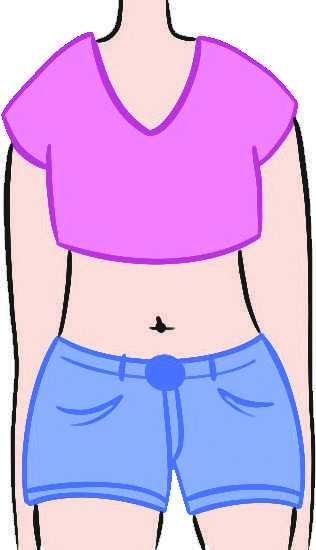Thrift stores allow for a more sustainable lifestyle
As she browsed the clothing racks of the Salvation Army store, Cameron Herring ’21 searched for a piece that was both unique and trendy. The thrift store provided easy and affordable finds, which aligned with her pledge to reduce her carbon footprint and maintain a more sustainable lifestyle, she said.
“I feel like the new awareness for sustainability is a benefit to getting people to shop at thrift stores,” Herring said. “I also think that environmental sustainability is becoming more prominent in day-to-day life in what people value.”
People are becoming increasingly aware of clothing sustainability
Herring also said that the increase in awareness of clothing sustainability has led to more people shopping in second hand stores.
“It is now more popular to get your clothes from secondhand shops, and because of that, [people] are getting more trendy clothing options in these stores,” Herring said. “In the past, [thrift stores sold] secondhand clothes that nobody wanted. Now, it is like, ‘oh, I got this trendy new shirt at a secondhand shop.’”
Blame is being put on the fashion industry
As climate change gains awareness, many are placing blame on the clothing industry and its detrimental impact on the environment, Annabel Zimmer ’20 said.
“A lot of fast fashion retailers have recently started “greenwashing” because consumers are becoming more aware.” Zimmer said, “ A lot of them use really loose terms to say they’re “sustainable” or “green” but really this doesn’t mean anything, so I just think it’s important to look at these retailers with a close eye.”
According to the World Bank estimate, the fashion industry releases 10 percent of the world’s carbon emissions into the air and is responsible for 20 percent of all industrial water pollution annually.
Carbon emissions and water consumption are the two main issues of fast fashion
Katherine Kihiczak ’21 said that she has become well-informed of the issues stemming from fast fashion, as well as the benefits of purchasing sustainable pieces.
“[Sustainable fashion] eliminates two major issues relating to the fashion industry; carbon emissions from transporting the clothing and water consumption to make textiles,” Kihiczak said. “So not only does sustainable fashion cause us to consider clothing that outlasts trends, but it also [provides] clothing that is more ethically made.”
According to journalist Dana Thomas’s book, “Fashionopolis,” 20 billion articles of clothing are dumped before they reach stores, and the average garment in America is worn seven times before being tossed. Large apparel chains such as Zara and H&M and all contribute to this waste.
“I’ve lived in Topanga for a long time, with mountains, hippies and a lot of environmental activists, and after watching the True Cost documentary, which I would highly recommend, I began researching the fashion industry and discovered some super scary stuff that goes on behind the scenes,” Josephine Jennings ’22 said. “Fast fashion is extremely destructive to the environment because it takes an immense amount of materials, energy, water and carbon emissions to produce just one article of clothing.”
According to Fashionopolis, during a store’s manufacturing process, clothes undergo chemical processing. The chemicals used are extremely toxic, and can lead to abysmal effects on both the environment and the people living in the areas around the clothing factories.
Some students haven’t considered sustainable fashion
Sabina Yampolsky ’20 said she is an avid shopper at fashion chain stores, but has never taken sustainability into account.
“Some of the stores I shop at include Brandy Melville, Urban Outfitters and Abercrombie & Fitch,” Yampolsky said. “I have never looked into the business or commerce side of how my clothes get made, and I have never heard of fast fashion or sustainable fashion.”
Yampolsky is not alone, AP Environmental Science teacher Nadine Eisenkolb said. Only recently, has there been more awareness toward the effects of fast fashion, she said.
“The last two years are the only years where people have actually, specifically asked questions about the fashion industry and its impacts on the environment,” Eisenkolb said. “So I think there’s a positive change, whereas the first three years that I worked here, nobody talked about it.”
According to “Fashionopolis,” the concept of fast fashion is relatively new, just like the increasing activism with respect to the planet’s current ecological status.
Companies produce clothes quickly to be updated with the latest trends
The emergence of modern apparel production allows companies to quickly manufacture clothes as they gain popularity, placing trendy items into stores as the trends peak, Jennings said.
“In addition, fast fashion teaches people to constantly spend money trying to find validation through their self-image, while the companies are just using us to make the biggest profit possible,” Jennings said. “The worst part is, the Earth suffers most from this cycle, but neither the companies or the buyers are trying to make a difference.”
The increasing efforts of eco-friendly clothing production originate from in-demand sustainable brands, such as Reformation, according to the Los Angeles Times. The company publishes quarterly sustainability reports on their website, in which they describe how they produce clothing and track their environmental footprint. This includes reracking everything from each piece of clothing they create, to the fibers in the clothes to the dyes used for the clothes.
Some believe there is still an appeal to clothing franchises
French teacher Amandine Nelaton said that while she is aware of fast fashion and its environmental effect, she also understands the allure of brands like Zara and Forever 21.
“I like [Reformation’s] stuff, but it is very pricey, [and] not everyone can afford it,” Nelaton said. “I’m on a teacher’s salary, and buying a sweater for $400 isn’t in my budget.”
Companies need to take sustainability into account
Although Nelaton sees the upside to environmentally friendly brands, she said that companies also have to begin taking responsibility for the role their pricing plays.
“I’m all about changing our habits, but the companies have to help us as well,” Nelaton said. “The reality of society is that the big retailers are not on our side or the planet’s side when it comes to pricing.”
Nelaton said that although fast fashion is still the most realistic option for her, she hopes that environmental effects of the industry will gain more attention.
“I wish that stores would be a little more transparent as to where their clothes come from, who made them and what types of resources they had to use to make their clothes,” Nelaton said. “As a client, I’m not even thinking about this when I go in the store, and I think that’s bad. I think they should raise awareness and flip our mentality.”





























